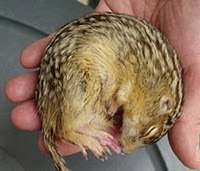Back in October keeper Marilyn told you about our woodchuck Wendy who was about to go to sleep for the winter. Wendy is awake now and following a daily pattern of eating and sleeping.
In this month’s Big Word post I thought I would explore some of the scientific terminology surrounding what we call hibernation. People often assume that an animal that hibernates simply goes to sleep for a longer time. However, research has shown that animals enter a number of states that may resemble sleep but differ in several critical ways.
 Ground squirrels are often cited as champions of hibernation in the animal kingdom. Some arctic species drop their body temperatures to within a couple of degrees of the freezing mark! The heart rate of hibernating ground squirrel can drop to only a couple of beats per minute. Black bears, like the ones that live at the museum, don’t enter into such a dramatic winter state. They add extra fat stores for winter and may sleep for days at a time but their metabolism never drops precipitously. Some scientists don’t think bears should be called true hibernators because their winter dormancy is less dramatic but the term is pretty well entrenched in common usage.
Ground squirrels are often cited as champions of hibernation in the animal kingdom. Some arctic species drop their body temperatures to within a couple of degrees of the freezing mark! The heart rate of hibernating ground squirrel can drop to only a couple of beats per minute. Black bears, like the ones that live at the museum, don’t enter into such a dramatic winter state. They add extra fat stores for winter and may sleep for days at a time but their metabolism never drops precipitously. Some scientists don’t think bears should be called true hibernators because their winter dormancy is less dramatic but the term is pretty well entrenched in common usage.
Hibernation is not just a period of deep unconsciousness. Individuals go through periods of near normal heart rate and breathing before dropping back into a deeper slumber. Scientists believe that animals need to rewarm periodically to allow critical body functions to occur. Some researchers have found that animals may need to wake up a little so their brains can sleep.
Today in Explore the Wild I saw a newly emerged painted turtle that was only about the size of a quarter. Later by the wetland overlook, I saw a banded water snake was stretched out in a tree. Reptiles like these animals can enter into a prolonged period of brumation, which is a lot like hibernation in mammals.
Some animals with high metabolic rates (birds, bats, small rodents) enter a hibernation-like state known as torpor. The heart rates and body temperatures of animals in torpor often drop dramatically. This ability appears to provide some protection from cold nighttime temperatures as well as saving some calories. Animals may enter torpor for a short period like one night or for longer periods. Some scientists think that Black bear hibernation would be better described as torpor.
Humans don’t hibernate or enter torpor but researchers have long wondered if we could be placed into such a state. A recent article on the Science News website reviews some interesting research on the subject of hibernation and how we might one day induce the state in humans for medical reasons.
If you are looking for more information about hibernation and hibernation-like states this Thinkquest website has a lot of great information.
Very nice, Larry, and great explanations!
What happens to frogs and fish that live in ponds that freeze over during the winter…do they hibernate too?
JMCA,Frogs and fish do go into a hibernation-like state, too. Frogs can be underwater for much of the winter and get oxygen through their skin to support their very slow metabolism. Fish may appear very lethargic and slow moving due to their slowed body processes.